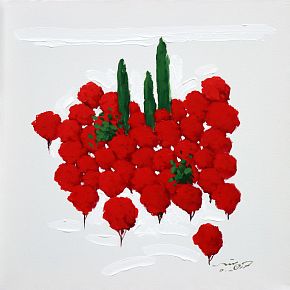Arman Yaghoobpour
Yaghoobpour is best known for his landscapes. His preferred subjects include natural scenery—such as green meadows and rows of poplar trees—as well as rural textures, like adobe-domed houses. The defining element of his work lies in his tactile approach to paint: he applies color in thick impastos, layering heavy masses of pigment side by side. This treatment of paint aligns with one of the central achievements of modernist painting—emphasizing the materiality of paint as a subject in its own right. Manouchehr Yektai was among the first Iranian artists to explore this potential, and his influence on Yaghoobpour’s painting is clearly discernible. It appears not only in the physicality of the brushwork but also in the tilted perspective that brings depth toward the surface of the canvas, the triangular compositions, the minimalist sensibility, and the dominance of white paint and raw canvas.
Trees and landscapes form the core of Yaghoobpour’s visual universe. When asked why depictions of trees remain unique despite their prevalence in painting, he responded: "The answer lies in your question. Each of these works has its own unique charm. Everyone depicts the tree from their own worldview. In Davood Emdadian’s works, the tree represents the grandeur and dignity of nature, while in Hossein Mahjoubi’s paintings, it conveys an ideal world. It is the artist’s mind that brings meaning. The tree is merely a pretext—through its branches, we ascend into the artist’s world."
Regarding the visual sources for his work, Yaghoobpour explains: "Many of my paintings are imaginative, but this imagination is shaped by images of nature stored in memory. Sometimes they may recall a specific place, but my goal is not to represent a particular site with objective accuracy."

